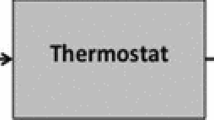Abstract
The contribution provides an example of how a formal model of some life-like functions – the so called eco-grammar (EG) system – provides a framework in which it is formally provable that the computational power of the model – under some very natural circumstances derived from the specificities of living systems, esp. from their embodiment – may overcome the computational limits of traditional computing models, perhaps also the computational power of the universal Turing machine.
Preview
Unable to display preview. Download preview PDF.
Similar content being viewed by others
References
Burgin, M., Klinger, A.(guest editors): Super-recursive algorithms and hyper-computation (special issue). Theoretical Computer Science 317, 1–267 (2004)
Csuhaj-Varju, E., Kelemen, J., Kelemenova, A., Paun, G.: Eco-grammar systems – a grammatical framework for lifelike interactions. Artificial Life 3, 1–28 (1997)
Csuhaj-Varju, E., Kelemenova, A.: Team behavior in eco-grammar systems. Theoretical Computer Science 209, 213–224 (1998)
Hopcroft, J.E., Ullman, J.D.: Formal Languages and their Relation to Automata. Addison-Wesley, Reading (1969)
Langton, C.G.: Artificial life. In: Langton, C.G. (ed.) Artificial Life, pp. 1–47. Addison-Wesley, Redwood City (1989)
Ronald, E.M.A., Sipper, M., Capcarrére, M.S.: Design, observation, surprise! A test of emergence. Artificial Life 5, 225–239 (1999)
Rozenberg, G., Salomaa, A.: The Mathematical Theory of L-systems. Academic Press, New York (1980)
Sieg, W.: The Church-Turing thesis. In: The MIT Encyclopedia of the Cognitive Sciences, pp. 116–117. The MIT Press, Cambridge (1999)
Wätjen, D.: Function-dependent teams in eco-grammar systems. Theoretical Computer Science 306, 39–53 (2003)
Author information
Authors and Affiliations
Editor information
Editors and Affiliations
Rights and permissions
Copyright information
© 2005 Springer-Verlag Berlin Heidelberg
About this paper
Cite this paper
Kelemen, J. (2005). May Embodiment Cause Hyper-Computation?. In: Capcarrère, M.S., Freitas, A.A., Bentley, P.J., Johnson, C.G., Timmis, J. (eds) Advances in Artificial Life. ECAL 2005. Lecture Notes in Computer Science(), vol 3630. Springer, Berlin, Heidelberg. https://doi.org/10.1007/11553090_4
Download citation
DOI: https://doi.org/10.1007/11553090_4
Publisher Name: Springer, Berlin, Heidelberg
Print ISBN: 978-3-540-28848-0
Online ISBN: 978-3-540-31816-3
eBook Packages: Computer ScienceComputer Science (R0)




